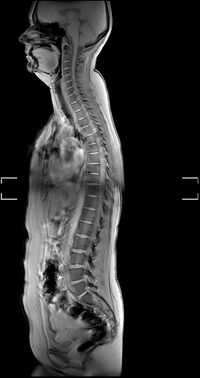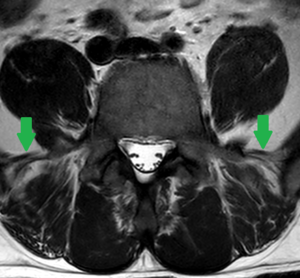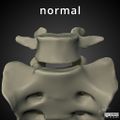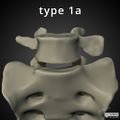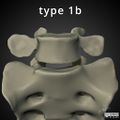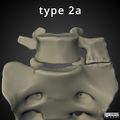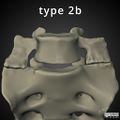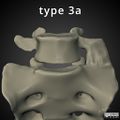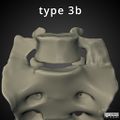Transitional Vertebral Anatomy: Difference between revisions
No edit summary |
No edit summary |
||
| Line 31: | Line 31: | ||
===Other features=== | ===Other features=== | ||
The lumbarised S1 may be squared and have facet joints and an intervertebral disc. The sacralised L5 may be wedged and have hypoplastic or absent jacet joints or intervertebral disc. | The lumbarised S1 may be squared and have facet joints and an intervertebral disc. The sacralised L5 may be wedged and have hypoplastic or absent jacet joints or intervertebral disc. | ||
===Castellvi classification=== | |||
{| class="wikitable" | |||
|- | |||
!Type!!Features | |||
|- | |||
|Type Ia||A unilateral TP height greater than or equal to 19 mm | |||
|- | |||
|Type Ib||Both processes heights greater than or equal to 19 mm | |||
|- | |||
|Type IIa||Presence of unilateral articulation between the TP and the sacrum | |||
|- | |||
|Type IIb||Presence of bilateral articulation between the TP and the sacrum | |||
|- | |||
|Type IIIa||Unilateral fusion of the TP and the sacrum | |||
|- | |||
|Type IIIb||Bilateral fusion of the TP and the sacrum | |||
|- | |||
|Type IV||Unilateral type II transition (articulation) with a type III (fusion) on the contralateral side | |||
|} | |||
<gallery> | |||
File:LSTV Normal.jpeg | |||
File:LSTV 1a.jpeg | |||
File:LSTV 1b.jpeg | |||
File:LSTV 2a.jpeg | |||
File:LSTV 2b.jpeg | |||
File:LSTV 3a.jpeg | |||
File:LSTV 3b.jpeg | |||
File:Castellvi classification.jpg | |||
</gallery> | |||
==Thoracolumbar transitional Anatomy== | ==Thoracolumbar transitional Anatomy== | ||
Revision as of 13:02, 16 August 2020
The most common vertebral arrangement is of 24 presacral vertebrae, consisting of 7 cervical, 12 thoracic, and 5 lumbar vertebrae. The cervical spine has a fixed vertebral count of 7, however the lumbar and thoracic vertebrae counts can be variable. Transitional vertebrae occur when there is overlap of developing somites during cranial-caudal border shifting. The vertebrae affected have morphology of a combined nature of the two adjacent vertebral regions.
Some people with transitional anatomy have 23 or 25 presacral segments. The most common variations are the presence of 13 rib-bearing thoracic vertebrae with four lumbar-type vertebrae, and 12 rib-bearing thoracic vertebrae with six lumbar-type vertebrae.
Transitional anatomy can also occur at the atlanto-occipital junction (atlanto-occipital assimilation: complete or partial fusion of C1 and the occiput, occipital vertebra: an additional bone between C1 and the occiput), and at the cervicothoracic junction (cervical rib arising from C7).
Prevalence
- The lumbarisation of S1 occurs in around 2% of the population. The sacralisation of L5 occurs in around 17% of the population.[1]
- Thoracolumbar transitional anatomy prevalence is unknown.[2]
- Cervical ribs occur in around 0.2 to 0.5% of the population
Lumbosacral Transitional Anatomy
Numbering Technique
It can be difficult to establish whether a LSTV is a lumbarised S1 or a sacralised L5, and there have been various techniques described, with the best technique being high quality imaging of the entire spine.[3] MRI reports should state the method of numbering and how the LSTV was determined.
Survey sequences
In New Zealand, some private radiology providers will do a sagittal survey sequence of the entire spine (also called a sagittal localiser) as routine while others do not. You then count from the odontoid peg of C2 inferiorly, rather than counting cranially from L5. One can identify the L1 vertebral body, and subsequently determine the correct numeric assignment of the LSTV. Radiographs of the entire spine can fulfil the same purpose. If there is only a normal lumbar spine radiograph, then correct numeration may still be possible, but it can be tricky at the thoracolumbar junction to differentiate the hypoplastic rib from the transverse process. Thoracolumbar transitions can also make things difficult without a full spine view.[3]
Using a sagittal localiser sequence assumes there are 7 cervical and 12 thoracic vertebra. The method does not account for thoracolumbar transitional anatomy or allow one to differentiate between dysplastic ribs and lumbar transverse processes. Adding a coronal localising sequence can sometimes increase the accuracy of locating the thoracolumbar junction.[3]
Iliolumbar ligament
Locating the iliolumbar ligament is another technique described. This ligament is present at the L5 transverse process in 96.8% of people.[4] On MRI it is a low signal intensity structure on T1 and T2 images and looks like a single or double band that extends from the transverse process of L5 to the posteromedial iliac crest. It serves to restrict flexion, extension, axial rotation, and lateral bending of L5 on S1. As with other landmarks, identification of the iliolumbar ligament is not sufficient to identify the L5 vertebral body, but it can be used to identify the lumbosacral junction as it identifies the lowest lumbar type vertebral segment.[4]
Other anatomic markers
Using other markers such as the aortic bifurcation, right renal artery, and conus medullaris has also been described and are not satisfactory.[3]
Other features
The lumbarised S1 may be squared and have facet joints and an intervertebral disc. The sacralised L5 may be wedged and have hypoplastic or absent jacet joints or intervertebral disc.
Castellvi classification
| Type | Features |
|---|---|
| Type Ia | A unilateral TP height greater than or equal to 19 mm |
| Type Ib | Both processes heights greater than or equal to 19 mm |
| Type IIa | Presence of unilateral articulation between the TP and the sacrum |
| Type IIb | Presence of bilateral articulation between the TP and the sacrum |
| Type IIIa | Unilateral fusion of the TP and the sacrum |
| Type IIIb | Bilateral fusion of the TP and the sacrum |
| Type IV | Unilateral type II transition (articulation) with a type III (fusion) on the contralateral side |
Thoracolumbar transitional Anatomy
Throacolumbar transitional vertebrae (TLTV) may have hypoplastic ribs of <38mm in length, but this feature is not sufficient for detection.
| TV Location | Naming | Frequency | Vertebral Segments | Anatomical Features |
|---|---|---|---|---|
| T12 | T12TLTV | ~2/3 | 24 (No additional) | Superior facets not directly posteriorly Intermediate mamillary bodies No prominent transverse process |
| L1 | L1TLTV | ~1/3 | Mostly 24 Rarely 25 with 6 lumbar vertebra Rarely 25 with 13 thoracic vertebra and ribs |
No costal facets for ribs. Transverse process aplasia/hypoplasia Superior facets asymmetrical and more posterior Remnant mamillary bodies |
Other Articles
See Konin et al for an open access review on the lumbosacral transitional vertebral (LSTV) anatomy.[3]
References
- ↑ Uçar et al.. Retrospective cohort study of the prevalence of lumbosacral transitional vertebra in a wide and well-represented population. Arthritis 2013. 2013:461425. PMID: 23864947. DOI. Full Text.
- ↑ 2.0 2.1 Du Plessis et al.. Differentiation and classification of thoracolumbar transitional vertebrae. Journal of anatomy 2018. 232:850-856. PMID: 29363131. DOI. Full Text.
- ↑ 3.0 3.1 3.2 3.3 3.4 Konin & Walz. Lumbosacral transitional vertebrae: classification, imaging findings, and clinical relevance. AJNR. American journal of neuroradiology 2010. 31:1778-86. PMID: 20203111. DOI.
- ↑ 4.0 4.1 Carrino et al.. Effect of spinal segment variants on numbering vertebral levels at lumbar MR imaging. Radiology 2011. 259:196-202. PMID: 21436097. DOI.
